Spring spinning pike fishing: gear and techniques
Spring is one of the “golden times” of the year for spinning anglers. At this time, most fish species, waking up after hibernation, begin to prepare for spawning and actively feed. Pike is especially active at this time.
Therefore, in this article we will consider such an interesting and catchy activity as fishing for pike in the spring on a spinning rod, touching upon not only where, when and with what bait a toothy predator should be caught, but also touching upon some of the intricacies of the technique and tactics of fishing for pike at this time of the year ...
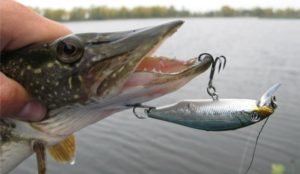
Content
- 1 The specifics of fishing for pike in the spring with a spinning rod
- 2 Where and when to spin pike in the spring
- 3 Features of fishing for pike in spring with spinning in March, April and May
- 4 Fishing rod for pike in spring
- 5 The main types of bait for pike in spring
- 6 Technique for fishing pike on a spinning rod in the spring and features of fishing from the shore and boat
The specifics of fishing for pike in the spring with a spinning rod
Unlike summer and autumn, spinning pike in spring has its own characteristics.:
- Fishing at shallow depths - at this time, the pike prefers places with stagnant water and a depth of no more than 1.5 meters.
- Application lures of small and medium size and low speed - after spawning, a weakened predator will rarely chase a very large lure moving at high speed.
- Fishing ban in some regions - in some regions there is a spawning ban on fishing for pike both from the shore and from a boat. It is necessary to take it into account in order not to pay a large fine later.
Where and when to spin pike in the spring
A place
The choice of location in the spring is especially important. Pike is caught in the spring by spinning from the shore in places such as:
- small rivers with slow flow and shallow depth;
- backwaters and bays;
- floodplain lakes;
- ditches and canals.
On the lake, pike is caught on spinning in spring in shallow waters with the remnants of last year's vegetation, on beaches and shallows bordering on snags or sharp dumps into holes.
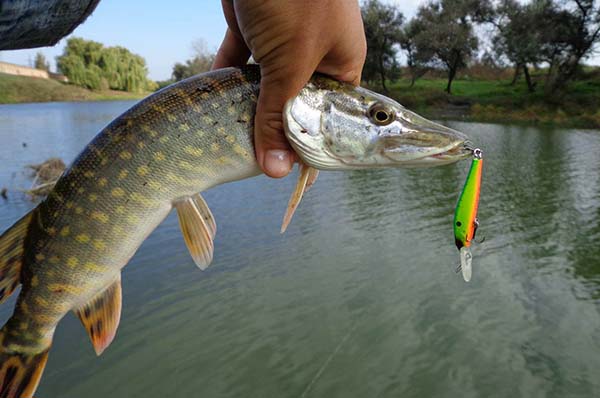
Times of Day
In spring, it is important to choose the right place, but the time of day for fishing. Choosing the time of day when it is better to spin the pike in the spring, it should be borne in mind that at this time the water is not yet warmed up enough, and there is no such clear division of activity into evening and morning bites as in summer:
- In the spring, the most catchy will be morning and afternoon hours - starting from 9-10 am and until 6-7 pm.
- Early morning as well as late evening pike due to low water temperature inactive and practically does not feed.
- With the onset of prolonged cold weather and bad weather with continuous low clouds, the biting stops altogether.
Weather
In addition to spawning and time of day, it affects the activity of pike in spring and the weather. The main weather characteristics affecting pike activity are pressure, air temperature, wind speed and direction:
- So the best pressure for pike fishing in spring - high, suitable for clear and sunny weather.
- Sharp jumps in pressure, its decrease, manifested in strong cold winds and bad weather, worsens or even stops biting.
- At the end of May, when May is warm or even hot, the pike can actively feed according to the summer schedule - in this case, its activity increases on warm, cloudy days with light warm rains and weak wind
Features of fishing for pike in spring with spinning in March, April and May
March
In many regions, spinning for pike is prohibited in March. In addition, during severe winters, most bodies of stagnant water and small currents are still frozen in ice.
Where there is no spawning prohibition and ice cover, it is best to fish for pike in small rivers and tributaries, shallow old people, in the mouths of rivers and streams flowing into lakes.
Video: Spring spinning pike fishing in March on the small river
April
In the post-spawning period (in April), the pike begins to actively feed, replenishing the energy expended on spawning. It should be caught at this time not far from spawning grounds, in shallow and quiet small rivers, backwaters, oxbows and floodplain lakes.
Video: pike chow in April
May
In early to mid-May, pike gradually leaves the spawning grounds and is distributed among the river summer camps. At this time, you should look for it near the thickets of young reeds, in the coastal and deep-water snags.
As the water warms and begins to bloom at the end of the month, the activity of the predator also decreases.
Video: pike fishing in May
Fishing rod for pike in spring
As well as at other times of the year, tackle for fishing pike on a spinning in spring plays a primary role along with the ability to use them. The tackle for pike spring spinning has the following characteristics:
- Rod - length from 2.1-2.4 (when fishing from a boat and for small rivers and streams) to 2.7 -3.0 (for large lakes and bays) with fast or ultra-fast action.
- Coil - size 2000-2500, with 3-5 bearings, front clutch.
- Cord (fishing line) - 0.08-0.1 mm.
- Leash - thin tungsten or steel, 15-20 cm long.
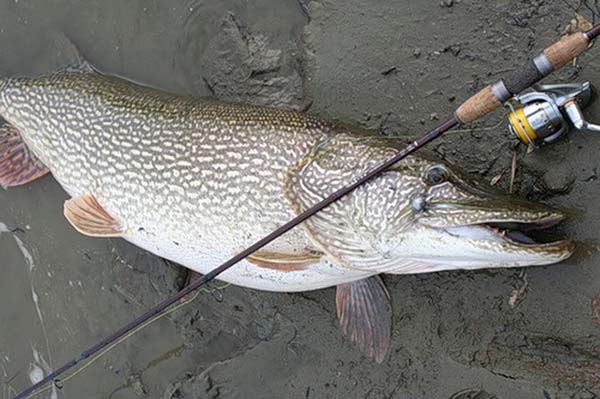
The main types of bait for pike in spring
When fishing for pike in the spring on a spinning lure, a wide variety of lures are used. Among this diversity, such groups should be distinguished as:
- Spoons - a lure for pike in the spring for spinning is a classic bait. Use at this time of the year large and medium-sized oscillating spoons, front-loaded rotating ones.
- Wobblers - in spring the predator responds well to floating and suspenders such as "Minnow", "Shad".
- Jig lures - twisters and vibro-tails in the spring are used with a size of at least 2-2.5 inches (5-7 cm).
- Poppers - the best are Kosadaka Takao, Sert Killer Pop and Daiwa TD Popper Zero and Duel / Yo - Zuri Eba Popper.
Also, in addition to artificial baits, they also use natural bait for pike for spinning in spring - fry and dead fish on special equipment.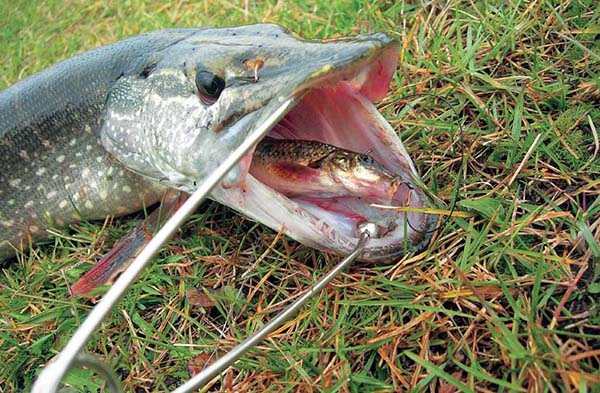
Technique for fishing pike on a spinning rod in the spring and features of fishing from the shore and boat
When fishing for pike in the spring, you should move as much as possible, fish for all promising places, often change baits, experiment with different types of wiring.
As during the whole season of spinning pike fishing in the spring, it is very important to correctly perform all its elements - from casting to sweeping:
Casting.When fishing on small lakes, small rivers, the most accurate and convenient will be lateral or pendulum casting, in which the bait flies a short distance, and trees or bushes do not interfere with casting the bait. If you want to make a medium-range cast and there are no obstacles overhead on the bank in the form of tree branches, tall bushes, then it is better to perform a vertical whipping cast.

It is very important for each cast to control the free running of the line or line through the row of pass rings of the blank - for this, by throwing back the bow of the line laying device and holding the line or line at the bend of the first phalanx of the index finger, bending it several times, gently pull it up. If the cord is not twisted over the blank and overwhelmed by the tip, it moves easily and effortlessly during such an operation.
Neglecting such a simple operation when casting, you can seriously damage the tip of the blank or cause the bait to "shoot" - because of the high inertia force, the leash attachment point breaks, and the bait flies into the water irrevocably.
Wiring... For pike fishing in spring, the type and speed of retrieval depends on the type of bait used:
Spoon
For posting lures at this time of the year, uniform posting is used at a slow or medium speed. Also, when fishing for pike on oscillating large spoons, stepped jig wiring is often used on the edges and dumps bordering the shallows.
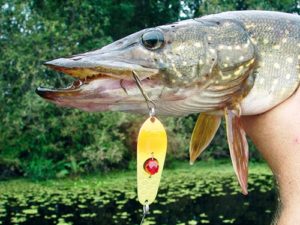
Video: fishing for pike in the spring with a spoon
Wobblers
When fishing with wobblers, they use both "Stop and go" and standard twitching. At the same time, pauses lasting from 2 to 3-5 seconds are added to the classic twitch. When driving "Stop and go", the wobblers are driven evenly with pauses lasting 2-3 seconds. These postings are most effective when fishing with narrow and maneuverable Minnow class suspenders - when fishing, they actively move from side to side, and during a pause freeze in the water column, thereby giving the pike the opportunity to attack itself.
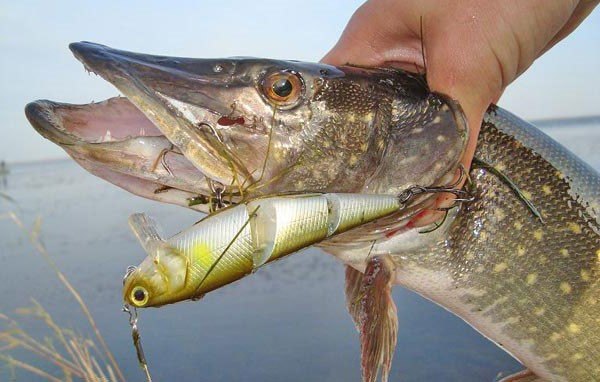
Video: fishing for pike with wobblers in spring
Jig lures
When fishing in spring with silicone lures - twisters, vibrotails, slugs, worms - a standard stepped wiring is used. The rewinding speed during posting should be slow or medium, the pauses between reeling should be longer than in summer. In areas with a clean bottom, the result can be obtained by the so-called dragging along the bottom - after casting and dropping the bait to the bottom, the tip of the blank is lowered to the water and slowly pulling the bait along the bottom soil with short pauses.

Video: spring jigging for pike
Poppers
Fishing for pike with poppers is effective in May, when aquatic vegetation begins to appear on the surface of the water. The lead of this bait is a standard twitching with the difference that the jerks should be as frequent, short and sharp as possible - only in this case, the bow concave part of the bait creates characteristic gurgling sounds that attract the predator.
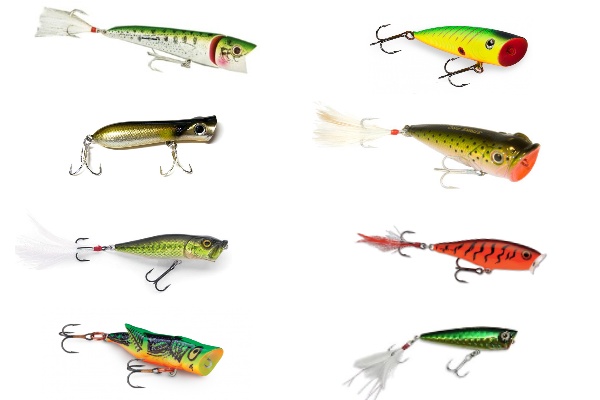
Video: spring fishing for pike on poppers
Sweep.It is necessary to perform a sweep for any suspicious strike. The sweep should be sharp and short. A very strong and sweeping sweep can, if caught on snags or grass, break the blank.
Rescue.If the sensations on the hook of the lure are medium or small grass pike, and the angler is confident in the strength and reliability of his spinning rod, then you can just pull out such a fish by quickly pulling it to the shore
Large pike, which is often caught in spring, should be fished out more delicately and carefully - when forcing the process, the cord or fishing line may break, and the upper knee of the rod may break. Experienced spinning fishermen use the “pumping” method to pull the trophy specimens - pulling the fish to the shore with a rod, immediately remove the resulting slack by winding the reel, then perform a new pull, and so on until it becomes possible to take the predator with a landing net or, having run aground, pull hands.
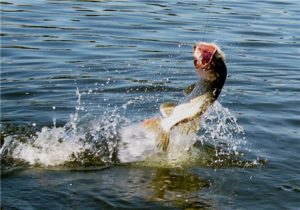
In no case should you raise large fish to a high bank from the water on an extended line with a rod - this can lead to breakage of the blank or breakage of the line when the fish jerks.
Fishing from the shore
Shore spinning fishing is the most affordable way to catch pike in the spring. It does not require a boat and has, in comparison with it, such distinctive features as:
- When fishing from the shore, special attention should be paid to those places where you can most productively fish for pike in spring on a spinning rod - shallows and shallow waters well warmed up by the sun, areas overgrown with last year's or fresh aquatic vegetation, snag and flooded bushes.
- When fishing pike from the shore in spring, you should use rods with a small test (up to 20 grams) and a length of no more than 2.7 meters. A universal spinning option for most bodies of water at this time will be a 2.4 meter rod with a test from 5 to 20 grams with a fast or ultra-fast action.
- Fishing of a promising place is carried out in a fan-like manner - the bait is thrown several times at different angles to the shore, thereby covering a vast water area.
- Shore fishing in spring should be as active as possible - places should be changed very quickly. If after 10-15 casts there were no blows or caught fish, move on to the next one.
Video: spring coastal pike jig
Fishing from a boat
If you are going to catch pike from a watercraft in the spring, you should clarify if there is a ban on the movement of boats and fishing from them. If there is no ban, then you can safely go to the pond. They catch pike from a boat at this time in those places where it is not possible to fish from the shore:
- in small, slowly flowing rivers with banks overgrown with bushes;
- in lakes with extensive shallow waters;
- in channels, ponds and bays with high thickets of last year's dry reeds.
Unlike coastal fishing, when fishing from a boat, shorter rods are used with a test of 5 to 15 grams. This is due to the fact that the boat has the ability to swim as close as possible to the promising place, and there is no need for a long spinning rod and heavy bait.
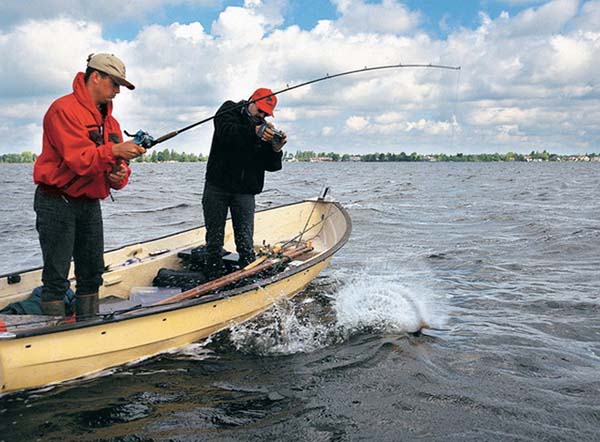
The technique of fishing for pike from a boat is somewhat different from the coastal one:
- Casting should be as soft and smooth as possible, otherwise the bait may end up on the branches of bushes or in reeds.
- When playing a pike (not even a large one), you should not give it the opportunity to go under the boat, this is in most cases fraught with descent.
- Having brought the predator to the side of the boat, it is carefully taken under the gills and sharply thrown into the boat.
- It is better to go fishing together, so that when a large specimen is caught, the partner can bring the pike into the landing net or take it by the side with his hand and throw it into the boat
When fishing from a boat in spring in shallow waters, it is better not to use the motor unnecessarily - in spring, in stagnant water, a fish, unlike a river, is very sensitive to noise.
Video: spring fishing for pike on the lake on spinning from a boat
Night fishing
Night pike fishing in spring is practiced if May is abnormally hot, and the predator, due to a decrease in the oxygen content in the water and an increase in its temperature, switches to a summer diet in advance. In this case, the predator can be caught at dusk, in the dark, and several hours before dawn.At midnight, it is inactive and practically does not feed.
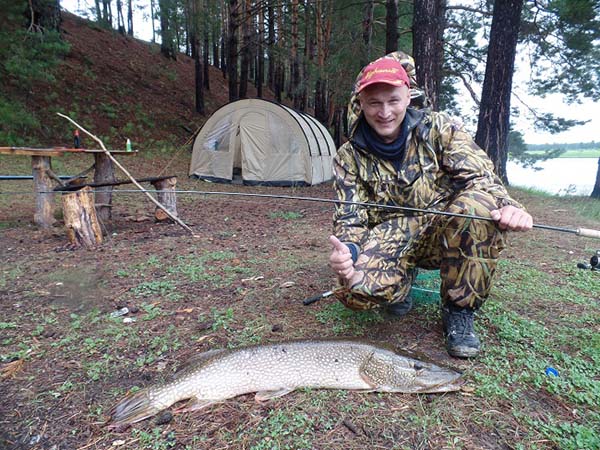
Learn all the secrets of spinning pike in spring can only be practiced diligently. Only after passing more than one kilometer of rivers and streams, backwaters and bays, having lost a lot of lures, feeling the tension of the fishing line and the cherished jerks of the hooked predator, every beginner eventually becomes a seasoned spinning fisherman.

